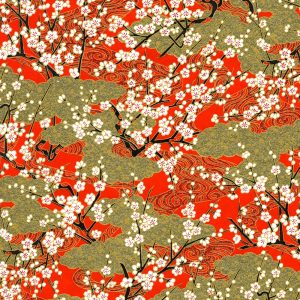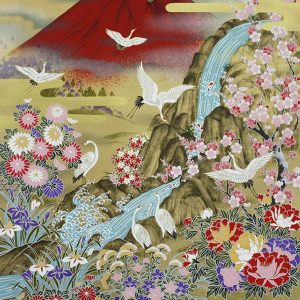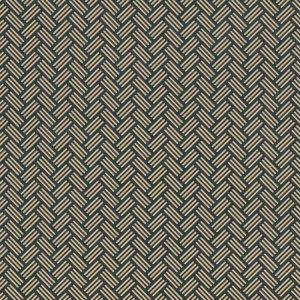Japanese papers
Washi
Washi is the Japanese word for the traditional papers made from the long inner fibres of three plants, wa meaning Japanese and shi meaning paper.
As Japan rushes with the rest of the world into the 21st Century, and more modern technologies take over, machines produce similar-looking papers which have qualities very different from authentic washi. In 2008 there remained fewer than 350 families still engaged in the production of paper by hand.
Durable and valuable, traditionally washi was used again and again.
History
Though paper was originally made in China in the first century, the art was brought to Japan in 610 AD by Buddhist monks who produced it for writing sutras.
By the year 800, Japan's skill in papermaking was unrivalled, and from these ancient beginnings have come papers unbelievable in their range of colour, texture and design.
It was not until the 13th century that knowledge of papermaking reached Europe - 600 years after the Japanese had begun to produce it.
By the late 1800's, there were in Japan more than 100,000 families making paper by hand. Then with the introduction from Europe of mechanized papermaking technology and as things "Western" became sought after including curtains (not shoji) and French printmaking papers (not kozo), production declined until by 1983 only 479 papermaking families were left. Today the few remaining families struggle to compete in the world market with handmade papers from India, Thailand and Nepal, where a lower cost of living makes it possible to produce papers more cheaply.
Raw materials
The inner barks of three plants — kozo, mitsumata and gampi — all native to Japan, are used primarily in the making washi.
Kozo (paper mulberry) is said to be the masculine element, the protector, thick and strong. It is the most widely used fibre, and the strongest. It is grown as a farm crop, and regenerates annually, so no forests are depleted in the process.
Mitsumata is the "feminine element": graceful, delicate, soft and modest. Mitsumata takes longer to grow and is thus a more expensive paper. It is indigenous to Japan and is also grown as a crop.
Gampi was the earliest and is considered to be the noblest fibre, noted for its richness, dignity and longevity. It has an exquisite natural sheen, and is often made into very thin tissues used in book conservation and chine-collé printmaking. Gampi has a natural 'sized' finish which does not bleed when written or painted on.
Other fibres such as hemp, abaca, rayon, horsehair, and silver or gold foil are some-times used for paper or mixed in with the other fibres for decorative effect.
Production
Branches of the (kozo, gampi or mitsumata) bush are trimmed, soaked, the bark removed, and the tough pliant inner bark laboriously separated, cleaned, then pounded and stretched.
The addition of the pounded fibre to a liquid solution, combined with tororo-aoi (fermented hibiscus root) as a mucilage, produces a paste-like substance when it is mixed.
It is this "paste" which is tossed until evenly spread on a bamboo mesh screen (called a su) to form each sheet of paper. The sheets are piled up wet, and later laid out to dry on wood in the sun or indoors on a heated dryer.
Features
Warmth.
Literally warmer to the touch than Western papers made of woodpulp, washi feels soft and creates a feeling of warmth in the viewer. Its tactile qualities make it wonderful for invitations and books.
Body.
Since the fibres are left long and pounded and stretched rather than chopped, washi has a deceptive strength. Pure-fibred washi can even be sewn and was used for armour and kimono-lining in earlier times.
Strength.
The length of the fibres and the nature of the raw materials ensure that washi is highly workable when wet. Thus it is excellent for papier maché, and etching in which the paper must be soaked. These long fibres produce a luxurious deckle edge, the rough edge which marks a handmade paper.
Soft translucency.
Kozo and mitsumata are naturally translucent fibres, a quality specific to paper from the East. As such, it is used regularly for the transmission of light.
Absorbency.
The nature of the fibres creates a ready absorption of inks and dyes. Papers that are "pure fibred" and dyed will result in much denser and more vibrant colour when fabric or watercolour dyes are applied.
Flexibility.
Since the fibres position themselves at random, there is no real grain to washi. This gives the paper a resistance to creasing, wrinkling and tearing - and means it can be used more like cloth, for covering books, or boxes etc.
Lightness.
Washi weighs much less than other papers of equal thickness. As a paper for books, it can create texts of apparent weightlessness.
Low acidity.
Traditionally-made Japanese papers are truly acid-free if they are unbleached and unsized. Examples of printed papers exist in perfect condition in Japan from 1000 years ago. Today, papers from the village of Kurotani are among the finest archival papers.
Decoration.
For centuries, colourful designs applied by woodblock or handcut stencils have created vividly characteristic papers, for decorative use. Recently, silkscreened chiyogami (small repeated-patterned paper) is available in an unbelievable range and widely used by craftspeople. Although made by machine, the quality available is about 70% kozo and comes in hundreds of patterns.
Uses
Printing
The special absorbency, strength and texture of washi results in unique images. Traditional Japanese printing was done by woodblock, but washi is also effectively used for wood engraving, linoblock, or letterpress techniques. It responds well to embossing, and can be used effectively for multi-colour lithographs and chine-collé (etching). Rembrandt often used Japanese paper for his fine etchings, David Milne painted on gampi tissue, and Canadian Inuit have for some years used washi to elicit the best results in their stone and stencil prints.
Collage
The broad range of textures, colours and patterns of the paper, and its wet strength, make washi a highly appropriate material for collage. Chiri papers, with their bark fragments and chiyogami are favourites for collage though all washi is suitable. In recent years, artists often paint watercolour over richly collaged "canvases."
Lighting
Washi has been used traditionally in screens and lamps and more recently in shutters and blinds to utilize its translucency. Mino, 'silk', seikaiha and unryu are commonly used. After being moistened, washi will shrink slightly when it dries, thereby tightening it more securely on a frame
Bookbinding
Washi's strength and flexibility make it excellent for book covers and end papers or for book sleeves and boxes. Its wet strength makes it ideal repair tissue. Kyoseishi, ungei heavy, 'silk', chiri and chiyogami are among those strong enough for book covers. Usumino and Kurotani #16 make especially strong repair tissue, but tengu, mino, and yame are also suitable.
Sumi-e and Shodo
Japanese printing and brush-writing using sumi, a natural carbon-based ink, are at their best on washi. Ise, kai, mino and all Kurotani papers are a few particular favourites for this use. For contemporary examples of art made with Japanese papers, please enjoy our online "inspiration gallery."
Many traditional uses of the paper have endured: origami, kites, doll and umbrella-making and unparalleled packaging. Today, its uses are limitless: paper jewellery; to cover mats in framing; used as a background for photography and to develop photographs on; to cover walls and furniture; to produce memorable wedding invitations and for a host of graphic design and public relations promotions.
As time goes on, modern technology replaces much of the traditional process. Still there are those papermakers left who will not compromise. According to the Japanese,
"Things of excellence shall not die."


